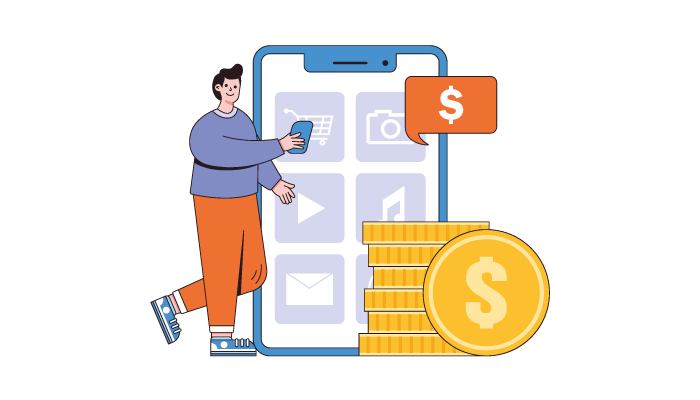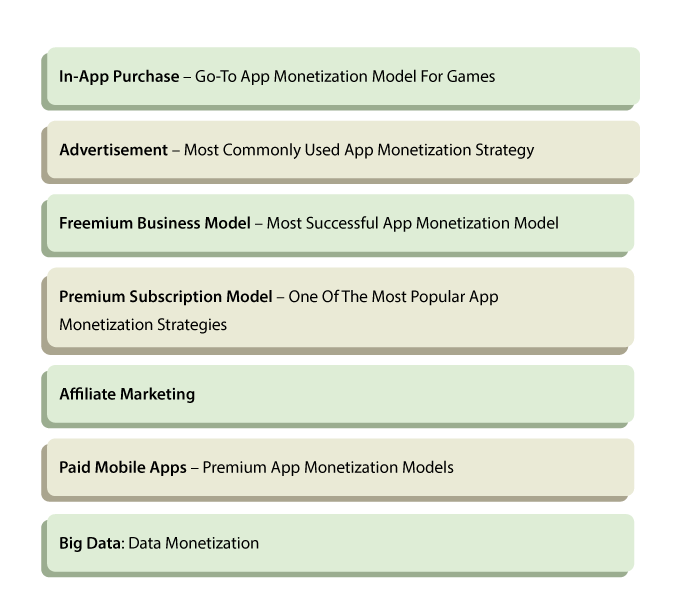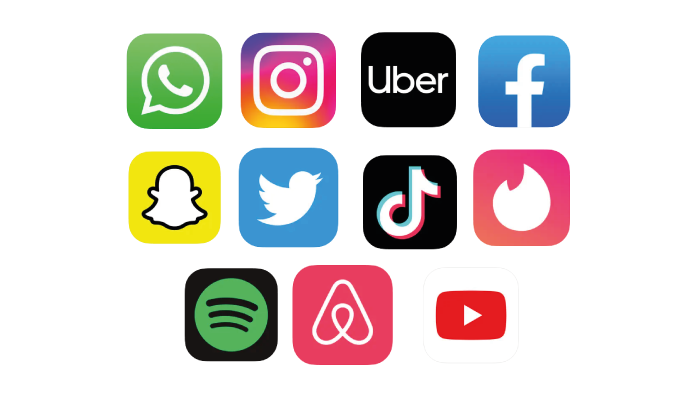Mobile App Development is a megatrend, but without app monetization it’s incomplete.
With 75% of the world’s population using smartphones, mobile apps are the new front for businesses, entertainment, commerce, socializing, and anything else you can imagine.
From social media apps like Instagram and Facebook to e-commerce apps like Amazon, mobile apps are generating billions.
In 2020 alone, mobile apps generated $581.9 billion in revenue. And it’s expected to grow much larger in the coming years.
But the big question is how?
Well, this is where app monetization comes in.
Mobile app monetization strategies are the key to generating revenue with your mobile app.
So, if you want to create an app and make millions, this blog is for you. Here, we shall be discussing everything related to how to make money with monetization strategies regardless of the type of app.
So with that being said, let’s get right into it:
What is an App Monetization Strategy?

What is app monetization?
This is a question that a lot of people ask when they are first introduced to the term mobile app monetization.
App monetization refers to the process of generating a sustainable revenue stream via the user base of a mobile app.
In layman’s terms, monetization strategies are the different ways of making money through mobile applications.
Let’s look at some statistics about mobile app monetization:
- The global mobile advertising market is projected to reach $281.4 billion by 2023.
- The average revenue per user (ARPU) for gaming apps in the US is $1.93, while non-gaming apps have an ARPU of $0.53.
- 45% of app users are willing to watch rewarded video ads in exchange for in-app rewards.
- In-app advertising accounts for 60% of app revenue, paid downloads account for 24%, and in-app purchases account for 16%.
But a lot of you might be wondering, is app monetization important?
We’ll answer your questions in the section below.
Is Mobile App Monetization Strategy Important?
So, why is app monetization important?
Why do people start businesses? How do they grow their business?
Well, there are a range of reasons like passion, the greater good, and whatnot. But something we can all agree on is that one of the biggest reasons why businesses develop a mobile app is to improve their business and generate more revenue.
And that is the exact reason why a mobile app monetization strategy is important.
After all, mobile apps as a whole generate billions or more. So, why don’t you take a piece of this cake for yourself?
User Experience & App Monetization
So, what’s the relationship between app monetization and user experience?
Well, user experience is what drives revenue.
To create revenue from the app, you first need to create value for the audience base. The reason is, that is what will drive users’ interest in your app.
So, it is a big reason to focus on UX in mobile app design.
In any case, let’s move on and go through the different mobile app monetization strategies.
How To Monetize An App? Best Mobile App Monetization Strategies for 2025

How to monetize an app?
Choose a mobile app monetization strategy!
Well, there are a range of mobile app monetization strategies. We understand that it can get quite confusing, especially when you are new to all of this.
That’s why we shall be going through the top 7 app monetization strategies, how to use them, their advantages, disadvantages, and more.
So, let’s get right into it:
| Method | Pros | Cons |
| In-App Advertising | Easy to implement and scalable | Can be intrusive, affects user experience |
| In-App Purchases | High revenue potential, enhances user experience | Requires careful balancing of pricing and features |
| Freemium Model | Wide user adoption, flexibility in pricing | Difficult to convert free users to paying customers |
| Subscriptions | Recurring revenue, high user engagement | Requires continuous updates and value addition |
| Sponsorship | Direct revenue and increased brand visibility | Needs a strong brand image and relevant sponsors |
| Affiliate Marketing | Passive income, no inventory management | Requires significant traffic and user engagement |
| Selling User Data | High revenue potential, no direct cost to users | can be seen as unethical and damage the brand image |
1. In-App Purchase – Go-To App Monetization Model For Games
Also known as IPA, in-app purchase is a simple yet super-effective mobile app monetization strategy.
What happens here is, the users can access the app for free and use its services. However, there are some special components of the apps that need to be purchased to use them.
A big example of in-app purchases is games like Call of Duty, where you can buy extra skins, guns, and areas. Plus, OnlyFans and InstaFeet are also big examples of the same.
As such, there are two types of in-app purchases that you can employ in your app.
They are:
Types of in-app purchases
Consumable
Consumable in-app purchases are temporary or limited in nature. Thus, they can be consumed. This is the reason why they are known as consumables.
In any case, they include:
- In-app currencies
- Pay For Extra Points
- Purchase Hints
None-consumable
On the flip side, non-consumable IAPs are just the opposite. The user only needs to purchase them once. And they are inexhaustible.
These include:
- Pay and unlock new levels
- Live Long Premium Membership
- Remove ads from the app forever
2. Advertisement – Most Commonly Used App Monetization Strategy
Well, we have all seen apps with a plethora of ads.
But did you know there’s a purpose behind it? Well, the in-app advertisement can make a lot of money.
Here’s what happens.
Once you have sufficient traffic on the app, you can start showing ads. There are a range of advertising networks.
Mobile App Ad Networks
- AdMob by Google: AdMob is a leading mobile advertising platform that offers a variety of ad formats, including banner, interstitial, and native ads.
- Facebook Audience Network: The Facebook Audience Network allows developers to monetize their apps with Facebook ads, which can be targeted to specific audiences based on their interests and behaviors.
- Unity Ads: Unity Ads is an advertising platform that is specifically designed for mobile games. It offers high-quality video ads that can be integrated seamlessly into games.
- AppLovin: AppLovin is a mobile advertising platform that provides personalized ads to users based on their preferences and past behavior.
- IronSource: IronSource is a mobile advertising platform that offers a variety of ad formats, including rewarded video ads, interstitial ads, and offerwall ads.
Let’s also look at the different types of advertisements that you can use in a mobile app.
Types of Mobile App Ads
- Banner ads
- Banner Ads
- Interstitial Ads
- Native Ads
- Video Ads
- Rewarded Ads
Moving on, in-app advertising is one of the best ways of app monetization.
There are examples of apps that have generated millions or even more with this method.
The best part is that this mobile app monetization strategy can be paired with a lot of different niches.
In any case, let’s move on to the next strategy for making money.
3. Freemium Business Model – Most Successful App Monetization Model
You’ve heard of free mobile apps, you must be using a lot of them. You’ve heard of the paid ones.
These are two different models on their own. But some genius had an amazing idea to combine these two models and double the revenue generation.
This gives us one of the, if not the most, successful app monetization strategies: the Freemium App Business Model.
This is one of the most common educational app business models. This is also super profitable.
So, what happens here is:
The app is offered to the user for free. However, to access the complete app, or rather the premium part of the app, you need to pay a one-time fee.
This is something that we often see in music streaming apps like Spotify and recruitment apps like LinkedIn.
Moreover, the popular mobile game, Clash of Clans, also uses this app monetization strategy on its platform.
4. Premium Subscription Model – One of the Most Popular App Monetization Strategies
Well, this is an app monetization model that you have certainly heard of.
A premium subscription model is something popular platforms use. And this generates a lot of revenue for them.
Here’s how this works:
- Mobile apps with a multi-tier subscription
- Subscription requires periodic payment
- Different subscription plans allow different levels of access
- The app may or may not have a subscription model
For example, we have all heard of the popular video streaming app Netflix. To access the content on this platform, you need to pay for a subscription to one of its plans.
On the other hand, there are dating apps like Tinder that allow users to access the plan for free. However, there are also several subscription levels.
This is all you need to know about this app’s monetization strategy.
5. Affiliate Marketing
Who hasn’t heard of affiliate marketing?
For those who don’t know, the term affiliate marketing refers to performance-based marketing strategies. And a very powerful mobile app monetization method if done right.
So, what happens here is that two businesses decide to affiliate with each other or in other terms become partners.
Here, they will promote each other. In layman’s terms, each business tries to provide leads or customers to another.
For the business, the business compensates the other business, and so forth.
Quite simple, right?
Here are a few examples of platforms that use affiliate marketing:
- Amazon Associates
- Shopify Affiliate Program
- Airbnb
- Bluehost
All in all, this is an app monetization model that is quite popular these days. And it’s something that you should check out for your next mobile app project.
6. Paid Mobile Apps – Premium App Monetization Models
Do you want to create a successful mobile app?
Well, one of the best app monetization models that you can go with is paid mobile apps.
There is no need for much explaining here. Users need to pay when downloading the app. This is often also known as the Pay Download Business Model.
Some of the paid apps that are available and their prices are as mentioned below:
| Application | Platform | Price |
| Minecraft | iOS, Android | $6.99 |
| Heads Up! | iOS, Android | $0.99 |
| Facetune | iOS, Android | $3.99 |
| Dark Sky Weather | iOS | $3.99 |
| AutoSleep Tracker | iOS | $2.99 |
| TouchRetouch | iOS, Android | $1.99 |
| Forest: Stay Focused | iOS, Android | $1.99 |
| Scanner Pro | iOS | $3.99 |
| ProCamera | iOS | $7.99 |
| Monument Valley | iOS, Android | $3.99 |
Let’s move on to the next mobile app monetization.
7. Big Data: Data Monetization
Big Data.
This is a word that is thrown around a lot in the world of IT.
But did you know that this is also one of the major App Monetization Strategies? Now, you do.
Data monetization refers to the process of selling user data. ( IT IS NOT ILLEGAL)
You can use user data licensing and a range of other methods to do this. Don’t worry, the data is not used for any unethical.
The data is given to third-party companies for marketing and research. Amazing right?
And let us tell you, if you have a good set of data, it’s worth A LOT.
Though the strategy is controversial, some of the biggest brands are using it. This includes:
- Social Media Apps like Instagram &Facebook
- Amazon
- Netflix
- Taxi Booking Apps like LYFT, Uber
The important thing that you need to keep in mind is to maintain transparency with users about their data.
Because when it comes to social media and location data, it can get a bit tricky.
Moving on, these are some of the best monetization strategies that you can come across in the world of mobile app development London, the US, anywhere.
Now, let’s look at some of the most popular apps and how they make money.
Famous Apps & Their Monetization Strategies

Ever wonder how some of the top fintech apps, dating apps, social media apps, etc make so much money?
For instance, Instagram alone makes revenue Billions. So, what’s the secret?
Well, here’s the app monetization some of the popular apps use.
| App Name | Monetization Strategy |
| Advertising and In-app purchases | |
| Advertising, Sponsored posts | |
| Advertising, Sponsored tweets | |
| Snapchat | Advertising and Premium subscriptions |
| TikTok | Advertising, In-app purchases |
| YouTube | Advertising, Premium subscriptions |
| Freemium (Free for the first year, then paid subscription) | |
| Spotify | Freemium (Free with ads, Premium subscription with additional features) |
| Uber | Commission on rides |
| Airbnb | Commission on bookings |
| Tinder | Freemium (Free with limited features, Premium subscription with additional features) |
This can be quite confusing, right?
Let’s see how to choose the best mobile app monetization strategy in the section below.
How To Choose The Right Monetization Strategy?
Whether it is a social media app development or something more technically advanced like eWallet app development.
Well, here’s a process to choose the right app monetization method for your app.
- Understand Your Audience
- Evaluate Your Product or Service
- Analyse Your Competitors
- Consider Your Business Model
- Test Your Monetization Strategy
But did you know that you don’t have to choose a one-app monetization strategy?
-
Hybrid App Monetization
As we saw in the previous section, most of the larger companies use multiple monetization methods for the app.
Well, this is something we call hybrid app monetization models.
Here, based on your app and what you are offering, you may use more than one monetization strategy.
For instance:
- Instagram uses advertising and data monetization
- Tinder also uses data monetization and a subscription-based model
For more information on the same, we highly recommend that you consult a development firm.
How Much Money Can You Make With Mobile Apps?

Let’s answer a very important question.
How much money can you make with mobile app monetization?
Well, the answer is, if you monetize the app the right way, update it, maintain it, and do the right things at the right time, you can make millions.
Here’s an example:
| App Name | Revenue (in billions of USD) |
| TikTok | 2.5 |
| YouTube | 19.8 |
| 13.9 | |
| 9.5 | |
| 70.7 | |
| 2.0 | |
| Messenger | 2.4 |
| Snapchat | 1.7 |
| 3.7 | |
| Netflix | 25.0 |
And with that, we have come to the end of the blog.
Conclusion
App monetization is the key to making money with your mobile app. So, if you are someone who has a mobile application or wants to create one and then monetize it, this blog will tell you everything about it. And with that, we conclude our blog.
FAQs
The revenue generated from app monetization varies widely depending on the type of app, its target audience, and the monetization method used. It is important to set realistic revenue goals and continuously analyze and optimize your monetization strategy to maximize revenue.
Yes, there are various legal issues to consider when monetizing an app, such as privacy policy, data protection, and compliance with app store guidelines. It is recommended to consult with a legal professional to ensure that your app is compliant with all relevant laws and regulations.
Yes, it is possible to change your app’s monetization strategy later on, but it is important to consider the potential impact on your users and revenue. It is recommended to conduct thorough research and testing before making any major changes to your app’s monetization strategy.
App monetization is the process of earning revenue from a mobile application.
Here are some popular methods to monetize your app:
- In-App Advertising
- In-App Purchases
- Freemium Model
- Subscriptions
- Sponsorship
- Affiliate Marketing
- Selling User Data
An app can be monetized in the following ways:
- Develop a monetization strategy
- Choose a monetization model
- Integrate the monetization method into the app
- Track and optimize the app’s monetization performance
A free app can still make money through the following methods:
- In-App Advertising
- Freemium Model
- Selling User Data

Niketan Sharma is the CTO of Nimble AppGenie, a prominent website and mobile app development company in the USA that is delivering excellence with a commitment to boosting business growth & maximizing customer satisfaction. He is a highly motivated individual who helps SMEs and startups grow in this dynamic market with the latest technology and innovation.
Table of Contents




No Comments
Comments are closed.